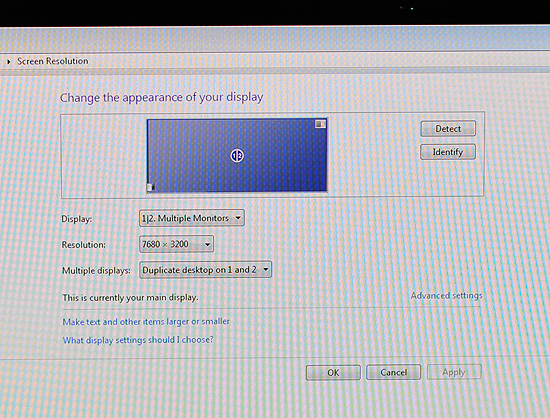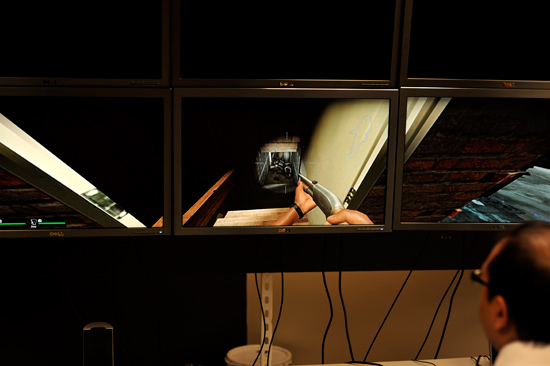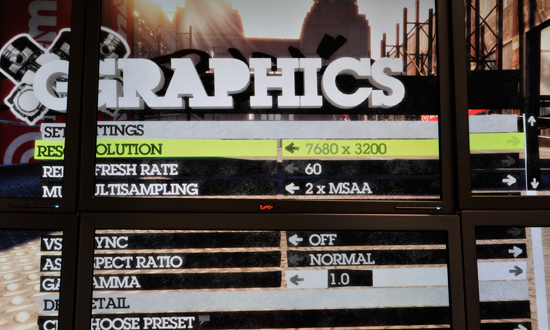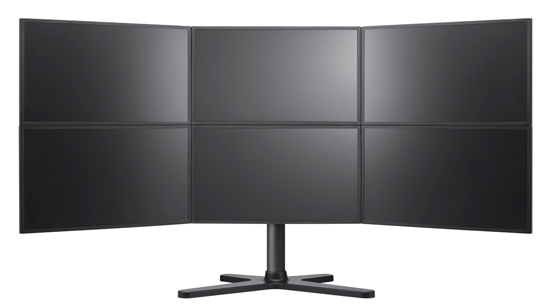Beginnings of the Holodeck: AMD's DX11 GPU, Eyefinity and 6 Display Outputs
by Anand Lal Shimpi on September 10, 2009 2:30 PM EST- Posted in
- GPUs
Wanna see what 24.5 million pixels looks like?

That's six Dell 30" displays, each with an individual resolution of 2560 x 1600. The game is World of Warcraft and the man crouched in front of the setup is Carrell Killebrew, his name may sound familiar.
Driving all of this is AMD's next-generation GPU, which will be announced later this month. I didn't leave out any letters, there's a single GPU driving all of these panels. The actual resolution being rendered at is 7680 x 3200; WoW got over 80 fps with the details maxed. This is the successor to the RV770. We can't talk specs but at today's AMD press conference two details are public: 2.15 billion transistors and over 2.5 TFLOPs of performance. As expected, but nice to know regardless.
The technology being demonstrated here is called Eyefinity and it actually all started in notebooks.
Not Multi-Monitor, but Single Large Surface
DisplayPort is gaining popularity. It's a very simple interface and you can expect to see mini-DisplayPort on notebooks and desktops alike in the very near future. Apple was the first to embrace it but others will follow.
The OEMs asked AMD for six possible outputs for DisplayPort from their notebook GPUs: up to two internally for notebook panels, up to two externally for conncetors on the side of the notebook and up to two for use via a docking station. In order to fulfill these needs AMD had to build in 6 lanes of DisplayPort outputs into its GPUs, driven by a single display engine. A single display engine could drive any two outputs, similar to how graphics cards work today.
Eventually someone looked at all of the outputs and realized that without too much effort you could drive six displays off of a single card - you just needed more display engines on the chip. AMD's DX11 GPU family does just that.

At the bare minimum, the lowest end AMD DX11 GPU can support up to 3 displays. At the high end? A single GPU will be able to drive up to 6 displays.

AMD's software makes the displays appear as one. This will work in Vista, Windows 7 as well as Linux.
The software layer makes it all seamless. The displays appear independent until you turn on SLS mode (Single Large Surface). When on, they'll appear to Windows and its applications as one large, high resolution display. There's no multimonitor mess to deal with, it just works. This is the way to do multi-monitor, both for work and games.

Note the desktop resolution of the 3x2 display setup
I played Dirt 2, a DX11 title at 7680 x 3200 and saw definitely playable frame rates. I played Left 4 Dead and the experience was much better. Obviously this new GPU is powerful, although I wouldn't expect it to run everything at super high frame rates at 7680 x 3200.

Left 4 Dead in a 3 monitor configuration, 7680 x 1600

If a game pulls its resolution list from Windows, it'll work perfectly with Eyefinity.
With six 30" panels you're looking at several thousand dollars worth of displays. That was never the ultimate intention of Eyefinity, despite its overwhelming sweetness. Instead the idea was to provide gamers (and others in need of a single, high resolution display) the ability to piece together a display that offered more resolution and was more immersive than anything on the market today. The idea isn't to pick up six 30" displays but perhaps add a third 20" panel to your existing setup, or buy five $150 displays to build the ultimate gaming setup. Even using 1680 x 1050 displays in a 5x1 arrangement (ideal for first person shooters apparently, since you get a nice wrap around effect) still nets you a 8400 x 1050 display. If you want more vertical real estate, switch over to a 3x2 setup and then you're at 5040 x 2100. That's more resolution for less than most high end 30" panels.
![]()
Any configuration is supported, you can even group displays together. So you could turn a set of six displays into a group of 4 and a group of 2.
It all just seems to work, which is arguably the most impressive part of it all. AMD has partnered up with at least one display manufacturer to sell displays with thinner bezels and without distracting LEDs on the front:

A render of what the Samsung Eyefinity optimized displays will look like
We can expect brackets and support from more monitor makers in the future. Building a wall of displays isn't exactly easy.










137 Comments
View All Comments
SnowleopardPC - Sunday, September 13, 2009 - link
"um projectors?buy 6 cheap led projectors, 800x480 resolution each, easily make a surround setup with it too.
best part is no bezels. thats the ticket. "
What in the world is that about. I think everyone here is looking at a minimum resolution of 1920x1080 or 1920x1200 for a 24 inch panel. To get that in a projector would cost about $2400 right now per projector.
For me to do that with this step, I would need 6 of them.
Now if you are talking about 30 inch panels, then the resolution per panel is 2560x1600.
Try finding a projector that normal people can afford with the pixel count, and then multiply it by 6
Once Dell comes out with an OLED 30 inch panel with out a bezel I am in for 6 of them.
HD TV is already obsolete and it has been for a long time.
Shadowmaster625 - Friday, September 11, 2009 - link
I dont really see the appeal of a wraparound display in the concave styles. No matter what you do it isnt going to be 3D and its not going to fool anyone.However, imagine if you took 2 monitors and angled them in the opposite manner, so that they were at a slight angle away from you. Convex in other words. Then you can generate a convincing 3D image. In theory, if you had a semi-spherical display, it could generate a very convincing 3D image. It would take some powerful software, but it would look cool as hell.
diggernash - Friday, September 11, 2009 - link
Don't know if it is mentioned above, but you can throw 3 (well 6 now) LCD projectors onto angled screens and do away with the bezel lines all together. And no, it does not work the same as projecting one big screen. The screens on the side definitely add to the experience.diggernash - Friday, September 11, 2009 - link
take that LCD outta my comments, massive brain failurekekewons - Friday, September 11, 2009 - link
Right. Probably better using DLP projectors (particularly since the latter are more flexible with regard to 3D technologies.xetura - Friday, September 11, 2009 - link
If you've never used a multi-monitor setup, you know that the monitor edges don't mean jack squat. For a triple setup, you don't actually look at the outer monitors. They're for peripheral vision. Alot of people miss the point entirely on that. Now for a x6 setup, yes this would be annoying, but for 3x or 5x setups, you don't even notice it. After racing on a x3 setup, racing on anything else is completely pointless. It's something that truly needs to be experienced to understand.kekewons - Friday, September 11, 2009 - link
I agree, if for no other reason that a 6x2 setup would have two of the six monitor top/bottem edges close to the center of the large image. I'm quite sure it would be unworkable for me, in the long run.Doesn't mean the vertical monitor edges in a 3 monitor rig are as intrusive, however, and I tend to believe they wouldn't be, yes.
They won't be, if your brain can get past them, any more that the low resolution/hi-pixelization image of a large, close projection would be.
But the big question is "IF." Yes, I can look past the low res image out onto the imaginary road beyond...but others might find it more difficult.
And maybe you can easily ignore vertical edge on a flatscreen, while I find it more difficult to do so....
Projection solutions should make both of those issues easier to solve.
Agree too that the tow peripheral monitors (or projections) in a three monitor/projector setup should NOT require either hi-resolution or even focus--ideally they are seen out of the corners of the two eyes, and are important only for determining overall sense of speed when driving--for viewing "objects passing by at high speeds."
willssi - Friday, September 11, 2009 - link
The person who took the pictures for the article should have been standing further back. For displays this large, they actually don't look good if you're too close to them. Something like the 2 x 3 setup would require you be a good 10 - 15 feet away from it to make the bezels less noticeable and really show off the massive resolution.Home theater guys will tell you when you're buying a big screen TV that you need XX feet from the TV, minimum, for it to look good. Same goes for this setup. The best picture was the last one on the 2nd page, of Dirt 2 I believe. A little distance back really shows off how crisp and huge this display setup is. Seeing several balding white guys sitting 2 feet from this massive display doesn't really give you a sense of how it will look in person.
kekewons - Friday, September 11, 2009 - link
I can appreciate the desire NOT to see individual pixels in any given image, and, yes, I certainly share that ultimate goal......but at the same time, I think there IS something to be said for seeing a very large image up close--at a certain point, the "immersion" factor kicks in, and it really can help offset the downside of seeing a large image under low-resolution.
I drive racing simulations using a XGA resolution projector, and I have it set up to throw a LARGE image not far from my eyes--60" horizontal image (4:3) only 36" or so from my eyes.
It certainly IS pixelated, yes. The Windows hourglass is just silly.
But when used to experience a "3D space" I find myself looking through the screen...and therefore past the pixels...into that 3D world.
I will agree in the next breath that seeing 2D chat can be a problem, however. :D
So I often turn it off....
Noctifer - Friday, September 11, 2009 - link
Ye, it looks better from the distance rather than from close. But most people won't use Eyefinity, the really great part of the card is its power. I mean being able to run Dirt 2 on a playable frame rate on such a high resolution is quite impressive.Can't wait till some PC magazines get their hands on one of those and show us the real difference in power compared with current cards.